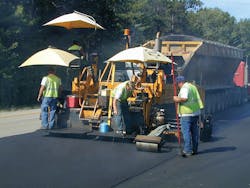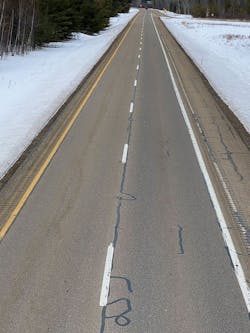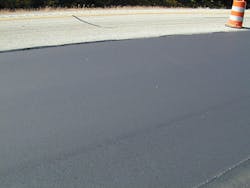Michigan DOT collaboration delivers cost-effective pavement solution
The U.S. has over 3 million miles of paved public roadways.
Our nation’s vast roadway system connects citizens to goods, services, and one another, but systems need to be managed. A good asset management system understands that assets require developing, operating, maintaining, and eventually selling. Depending on costs, the goal is to find the most cost-effective path to keep an asset useful over its life cycle. For pavements, the life cycle is long, as pavements serve a community for decades, and one way to further extend a pavement’s useful life is to conduct preservation treatments. Pavement preservation is a proactive approach to protect and maintain existing pavements. In the long run, preservation can reduce greenhouse gas emissions, cost, and traveler delay. One tool in an agency’s toolkit is the use of asphalt overlays, which provide a smooth asphalt surface on a well-performing roadway to extend the pavement’s life, add structure, and enhance driver satisfaction with a smooth ride.
A dense graded surface course used over flexible or composite pavements for preventive maintenance is what is considered an ultra-thin asphalt overlay, or thinlay. Developed in the late 1950s in the city of Rockville, Maryland, and generally applied at a rate of 65-90 lb per sq yd or about 0.6-0.8 in. average thickness, these mixtures have a successful track record of providing smooth, safe, and cost-effective roadways to U.S. drivers.
The Michigan Department of Transportation (MDOT) and the Asphalt Pavement Association of Michigan (APAM) have worked cooperatively to develop an ultra-thin asphalt overlay specification for use in the state. Developed in 1998 specifically for placement on low-volume roadways as part of MDOT’s Capital Preventive Maintenance (CPM) program, Michigan has a 22-year history of success employing ultra-thin asphalt overlays. Revised cooperatively in 2001 to include specific mixtures for medium and high-volume roads, the revised specifications engineer the mixture to perform under increased traffic loads by utilizing polymer-modified binders as well as more angular aggregates.
What's the Benefit of Ultra-Thin Asphalt Overlays?
Among the benefits of ultra-thin asphalt overlays are protecting the pavement structure, slowing the rate of deterioration, correcting surface deficiencies, and improving skid resistance. In addition, drivers notice an improved ride quality. Placed with conventional paving equipment, thinlays can result in opening a road to traffic within seconds of the compaction equipment rolling off the asphalt pavement. Moreover, ultra-thin asphalt overlays are a cost-effective preventative maintenance treatment. When compared with other treatments, the cost per mile per year ranges from $6,000 to $8,000 against $11,000 for chip seal or micro-surfacing.
U.S. 127 in Roscommon County
Paved in 2004, as one of MDOT’s early medium-volume ultra-thin asphalt overlay projects, U.S. 127 is now 17 years in use. The project site is located from a quarter-mile north of Canoe Camp Road and runs north 9 miles to M-55 in Roscommon County. A main route in central Michigan for northern travelers, U.S. 127 is a four-lane divided freeway.
When scoping the project, MDOT engineers noticed the original pavement structure showed signs of oxidation, with some slight raveling and longitudinal cracking. Yet the existing pavement had a good cross-section, leading MDOT to select it as a good candidate for a medium-volume ultra-thin asphalt overlay. Considered an emerging technology in 2003, MDOT wanted to gather performance data on medium- and high-volume ultra-thin asphalt overlays before deciding whether to add them to its suite of standard preservations options.
Paved by APAM and National Asphalt Pavement Association contractor member Rieth-Riley Construction Company in the fall of 2004, a total of 329,000 sq yd (14,000 tons) of ultra-thin asphalt overlay was placed on the roadway at 0.75-in. thickness. The overlay covered the two 12-ft driving lanes plus 1 ft into the shoulder, stopping short of the rumble strips embedded into the shoulder as a safety measure to alert drivers before heading off the road. Larry Bushong, area manager for Rieth-Riley in Prudenville, stated “One of the great benefits of ultra-thin paving is how fast the process is. On this project we paved approximately 13 ft wide, so we covered a lot of ground in a day. Since you are installing it at half the thickness of a traditional overlay, contractors can cover twice the area. Also, by paving 13 ft wide, we eliminated the need for additional shoulder gravel and recutting of the rumble strips.”
As an emerging technology, MDOT originally estimated that ultra-thin asphalt overlays would provide a three- to five-year life extension, the same as other approved surface treatment options in Michigan. Due in part to the performance of this project, MDOT moved the medium-volume ultra-thin asphalt overlay treatment out of the emerging technology category to the approved pavement preservation category.
After 17 years in service, the U.S. 127 project in Roscommon County is performing much better than estimated, and still has significant service life left. With one surface ultra-thin asphalt overlay, the life of the pavement has been extended more than three times—the longest estimated extension of pavement life.
MDOT utilizes a pavement management system that measures and assigns a numerical value to pavement distress to come up with a Distress Index (DI). The range for DI is 0 to 50, 0 being distress-free (new pavement) and 50 being the end of life (major rehabilitation or reconstruction) for the pavement. MDOT collects DI data every two years for all its pavements (the latest data is from 2017).
In 2017, the U.S. 127 project’s DI was 3.6, which is very low even after 13 years of service.
Based on MDOT’s performance data, a typical asphalt pavement has a design life of 19 years without maintenance. When preventive maintenance is performed, it extends the pavement to a longer service life. Typically, MDOT models asphalt pavement with four preventive maintenance treatments, which extend the service life to 37 years. Jay Gailitis, MDOT’s Gaylord Transportation Service Center Manager, said, “The ultra-thin asphalt overlay placed on U.S. 127 is performing very well and has required only crack sealing as maintenance. The region was planning another round of surface seal preventive maintenance in 2022, but have pushed it back to 2023 due to the pavement’s low distress.”
With how well this ultra-thin asphalt overlay has performed, MDOT will most likely be able to reach a pavement age of 37 years with only two maintenance treatments, significantly reducing maintenance costs and stretching agency budgets. In addition, the ride for drivers is superb. Bushong commented: “I am amazed how well this pavement has performed. It is truly remarkable that this has lasted 17 years and counting, with only a single crack treatment. I travel this route to work every day, and it is still one of the smoothest portions of my commute.”
Further proof
While this ultra-thin overlay project greatly outperformed expectations, it is not alone. There are many other examples of projects showing similar extensions in service life and performance.
For preventive maintenance, the most important step is selecting the right fix at the right time. Even a good preservation treatment on a road in poor condition will fail. When performance-based data is used to manage the pavement maintenance cycles and the right treatment is placed on a pavement in good condition, with a good foundation, thinlays will significantly extend the life of a pavement. The U.S. 127 project was one such example: It had a good structure and very little distress, making it a perfect candidate.
Over the last 20 years, Michigan’s average cost per square yard of ultra-thin overlays has been similar to other surface sealing treatments. However, ultra-thin asphalt overlays also improve pavement smoothness and add structural value to a pavement, something the other surface sealing treatments cannot do. When placed on pavements in good condition, it is estimated that ultra-thin overlays extend a pavement’s life at least twofold over other pavement preservation options. Pavement owners can use the cost savings to stretch their budgets while improving other pavements within their transportation network.




